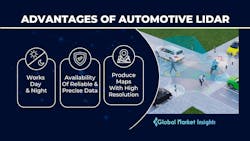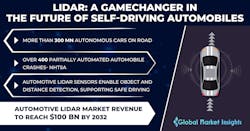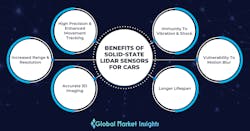With more than 30 million autonomous cars currently operating on global roads, the trend of self-driving automobiles is likely to take the automotive industry by storm. However, the safety of drivers and passengers has always been the subject of debate among different safety regulators with regard to partially automated driver assist systems. For the record, the National Highway Traffic Safety Administration reported nearly 400 partially automated vehicle crashes.
This has drawn credible attention toward the adoption of technologically sound systems that are not only user-friendly but also deliver optimum safety, such as the light detection and ranging (lidar) sensors.
Per a recent study, the global automotive lidar market is projected to be worth USD $100 billion by the end of 2032.
Importance of lidar sensors in automobiles
Over the years, lidar has been the go-to in the automotive business and used in several forms of ADAS. Blind-spot monitoring systems also use the technology to track vehicles before a lane change, ACC uses lidar to maintain a consistent distance between the vehicles on the road, and automatic emergency braking systems use it to bring a vehicle to halt before it contacts an obstacle. More so, given its 360-degree capabilities, the technology should enhance the quality and accuracy of safety alerts.
Automotive lidar advantages
Over the years, the market valuation of the automotive lidar is being fueled by many pros and opportunities of lidar sensors for automobile manufacturers:
- Works night and day: Lidar technology uses an active illumination sensor that enables its utilization both during the day and at night.
- Availability of precise and reliable data: Lidar’s short wavelength can detect small things and generate accurate 3D representations, enabling the car’s sensors to analyze any obstacles on the way.
Lidar sensors are able to accomplish range accuracy of 0.5 to 10 mm relative to the sensor and a mapping accuracy of 1 cm horizontal and 2 cm vertical.
- Maps with high resolution: Given its capacity to design high-resolution maps, lidar sensors are used in geography, archaeology, seismology, geology, and aerial laser swath mapping to collect precise and dense elevation data over shallow-water regions and landscapes.
Statistics depict that commercial lidar systems boast a maximum detection range of up to 300 meters concerning a reflectivity of 10 percent of the detection object.
How are market vendors and automobile dealers responding to the growing lidar significance?
Owing to its well-known prominence in the automotive industry, lidar sensors have now become an attraction for various conglomerates looking for advanced solutions to support the proper safety of autonomous vehicles. Some of the well-known strategies undertaken by them include:
- Bolstered production: Luminar’s efforts to increase productivity
In 2022, the automotive sensor firm announced commencing the production of its Iris lidar units for SAIC Motor, one of the largest Chinese automakers. Per reports, these units are being made in a factory in Mexico owned by Celestica. Both companies are building a new dedicated factory that will be able to produce 250,000 Iris units annually.
- Supply partnerships: Innoviz and Volkswagen Alliance for safe autonomous driving
Israel-based Innoviz, in mid-2022, declared it had received the contract for supplying its lidar sensors and perception software to all vehicles equipped with automated driving capabilities within the Volkswagen group. Official sources claim the firm would be working directly with Volkswagen’s automotive software arm -- Cariad SE -- to integrate its technology into its coming line of VW vehicles.
- Product showcase and innovations: Cepton’s launch of Nova for automotive headlamps
Cepton, Inc. — a high-performance lidar solution — demonstrated a lidar integration solution for automotive headlamps at IAA Transportation 2022 conference. The solution, named Nova, features a combination of high resolution, compact size, and robust field of coverage, which would help the vehicle accurately detect close-proximity objects including bicycles, pedestrians, and other obstacles on the road surface.
Mechanical vs. solid-state automotive lidar: Which is an ideal lidar solution for automobiles?
The automotive lidar business is dominated by different lidar sensors, out of which the mechanical and solid-state lidar are the prominent ones that are being increasingly used by automobile manufacturers. Given is a comparative analysis of mechanical automotive lidar and solid-state automotive lidar, which would enable the automotive sector to choose the best among both worlds:
Mechanical lidar: These sensors have been the talk of the town for over many years now as they are equipped with rotating assembly to create a 360-degree field of view, offering a wide FOV. One of the many reasons for its limiting popularity is the high production costs associated, given the bulky implementation.
Solid-state lidar: Solid-state lidar sensors, on the other hand, boast of reduced field of view subject to the absence of no spinning mechanical components. Also, in the current global inflation condition, the demand for these sensors is practically mounting due to low production and implementation costs compared to mechanical lidar.
Building on the aforementioned parameters, it is crucial to note that solid-state automotive lidar sensors are drawing massive attention over recent years.
Solid-state lidar: The future of autonomous vehicles
Solid-state lidar marked its debut in 2018 and is robustly gaining significance in the world of automobiles. These sensors can reduce the costs by more than 10 times while increasing the sensor range by more than over 200 meters.
Some of the other pivotal benefits offered by solid-state lidar include:
- High precision through better classification of objects, long-range detection, and enhanced tracking of movement.
- Ability to deliver increased range and resolution required for high-speed driving.
- Ability to offer accurate 3D imaging in any adverse weather condition.
- Increased immunity to vibration and shock.
- Reduced vulnerability to motion blur.
- Lifespan of up to 100,000 hours
Different companies are now leveraging these benefits and seeking to introduce products that adhere to the requirement of autonomous driving in recent times. For instance, RoboSense, in March 2023, launched its first automotive-grade solid-state lidar solution for L4 self-driving.
With advanced hardware and software support, the new RS-Fusion-P6 offers intelligent and precise environmental perception capabilities, allowing autonomous vehicles to steer through complex driving scenarios with ease. The solution also helps reduce costs and improve efficacy, promoting the rapid implementation of large-scale self-driving commercial operations.
The automotive lidar market in 2023 and beyond
The world is moving ahead on a new and exciting journey toward autonomous cars, and the technologies and architectures driving this space are in a constant state of flux. Although lidar is an all-new concept in this arena, the advantages that this technology offers are fueling rapid innovation as it seeks to catch up with more established sensor systems.





